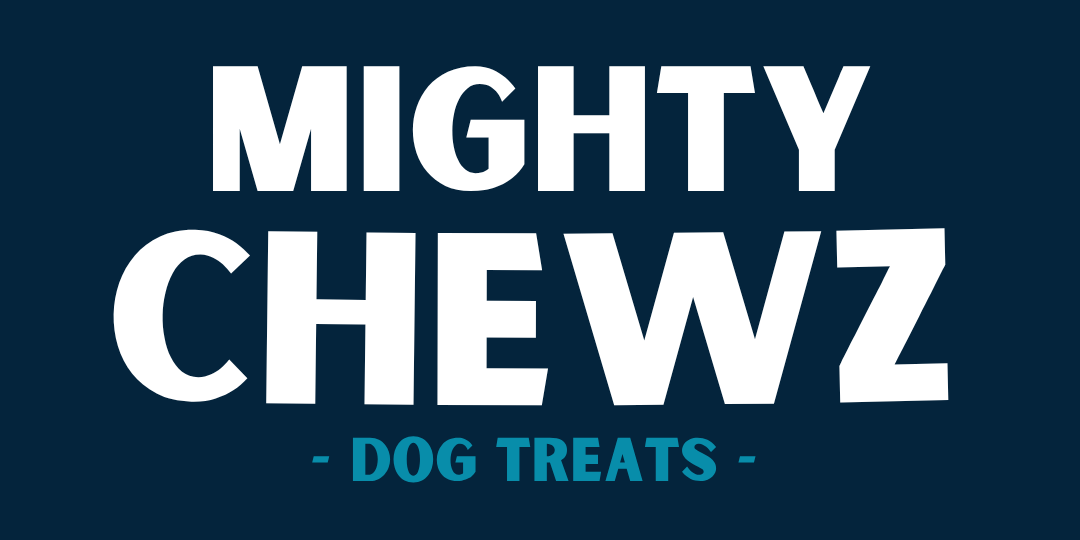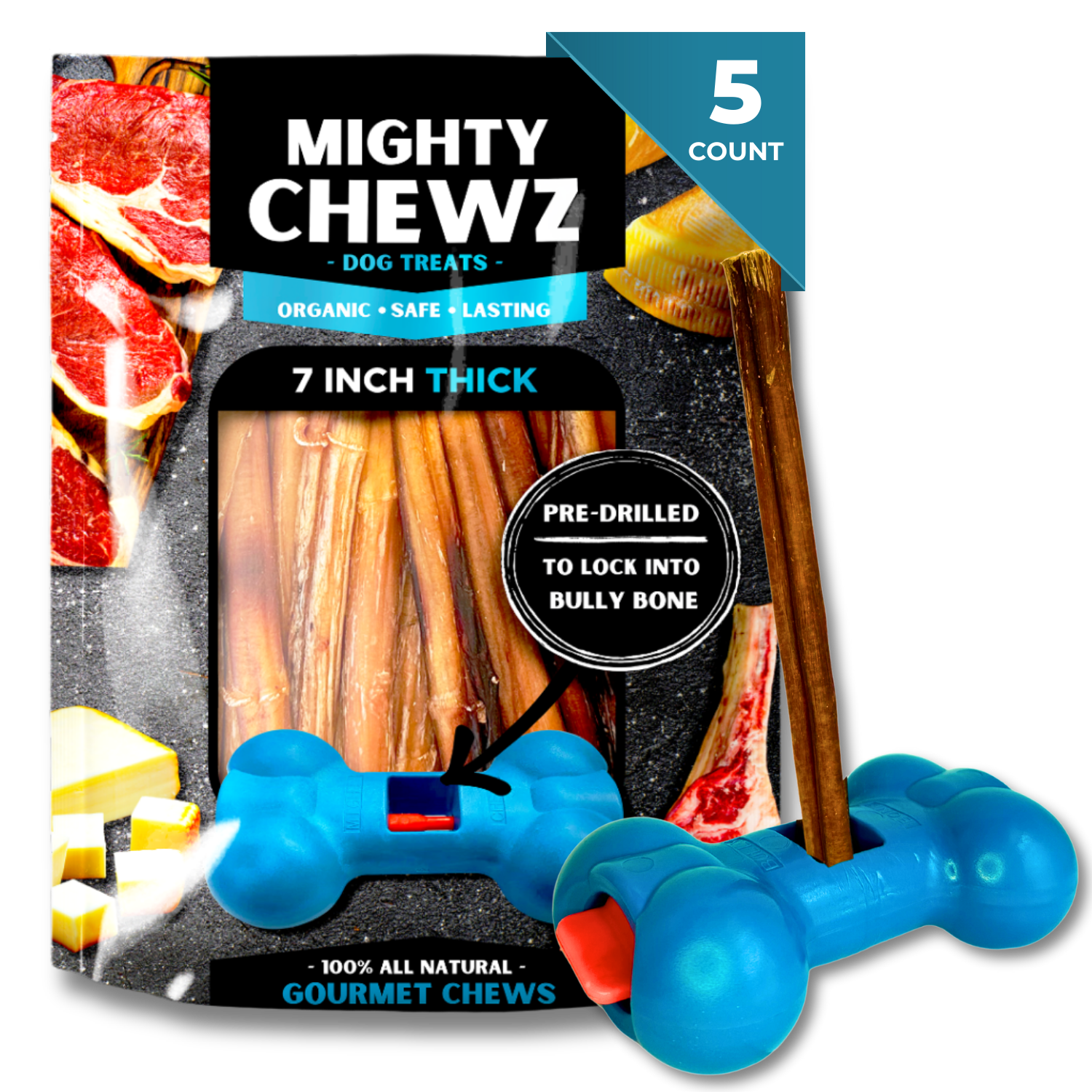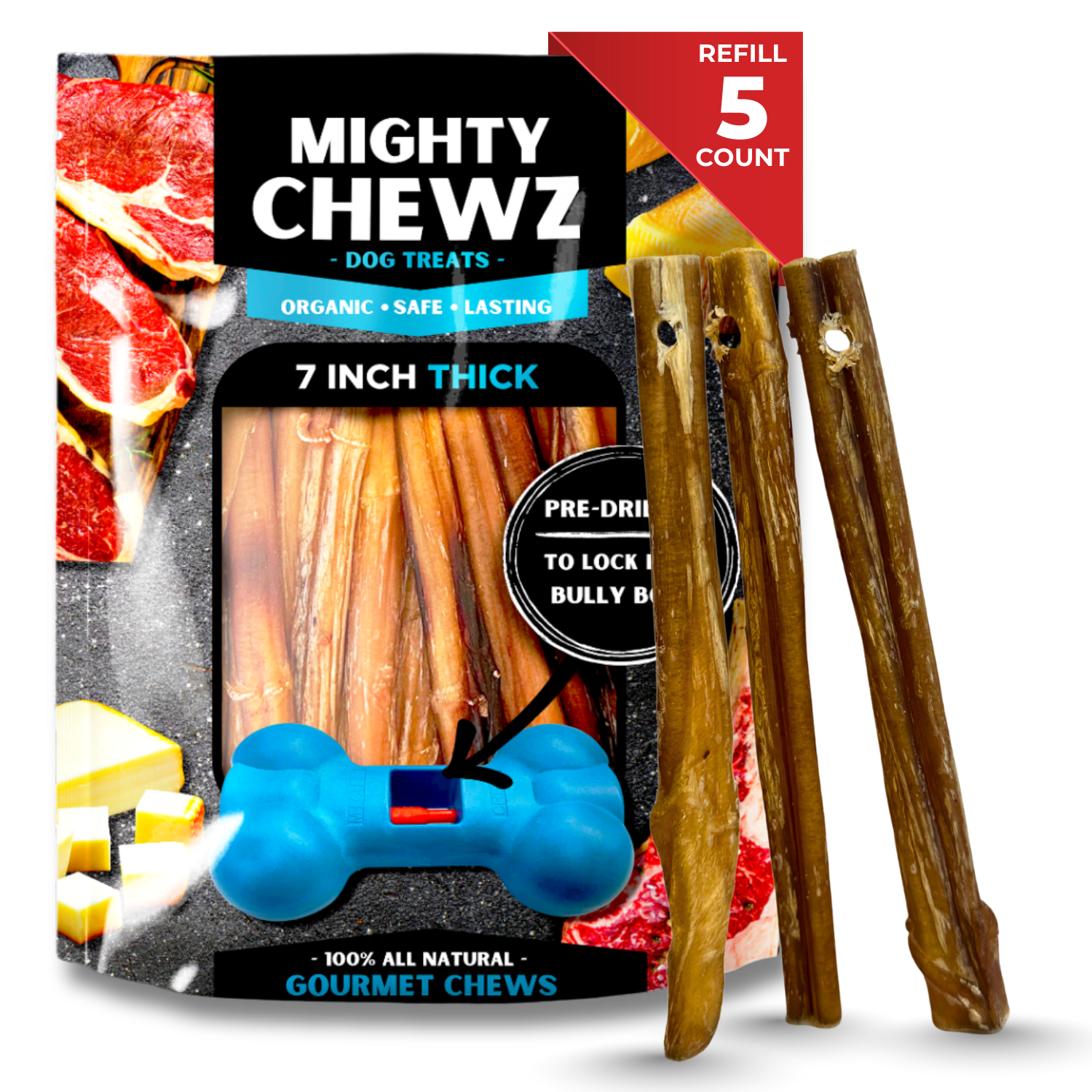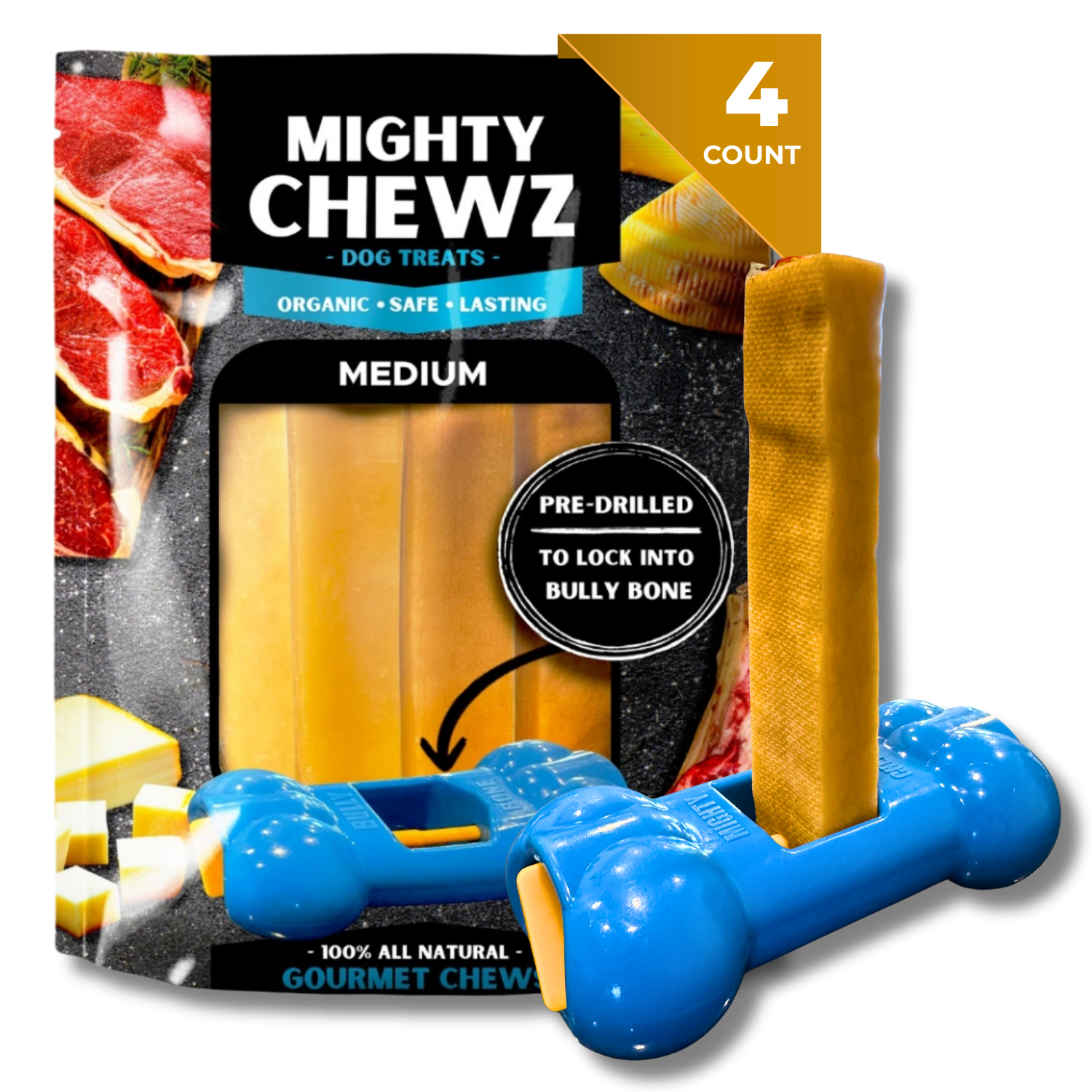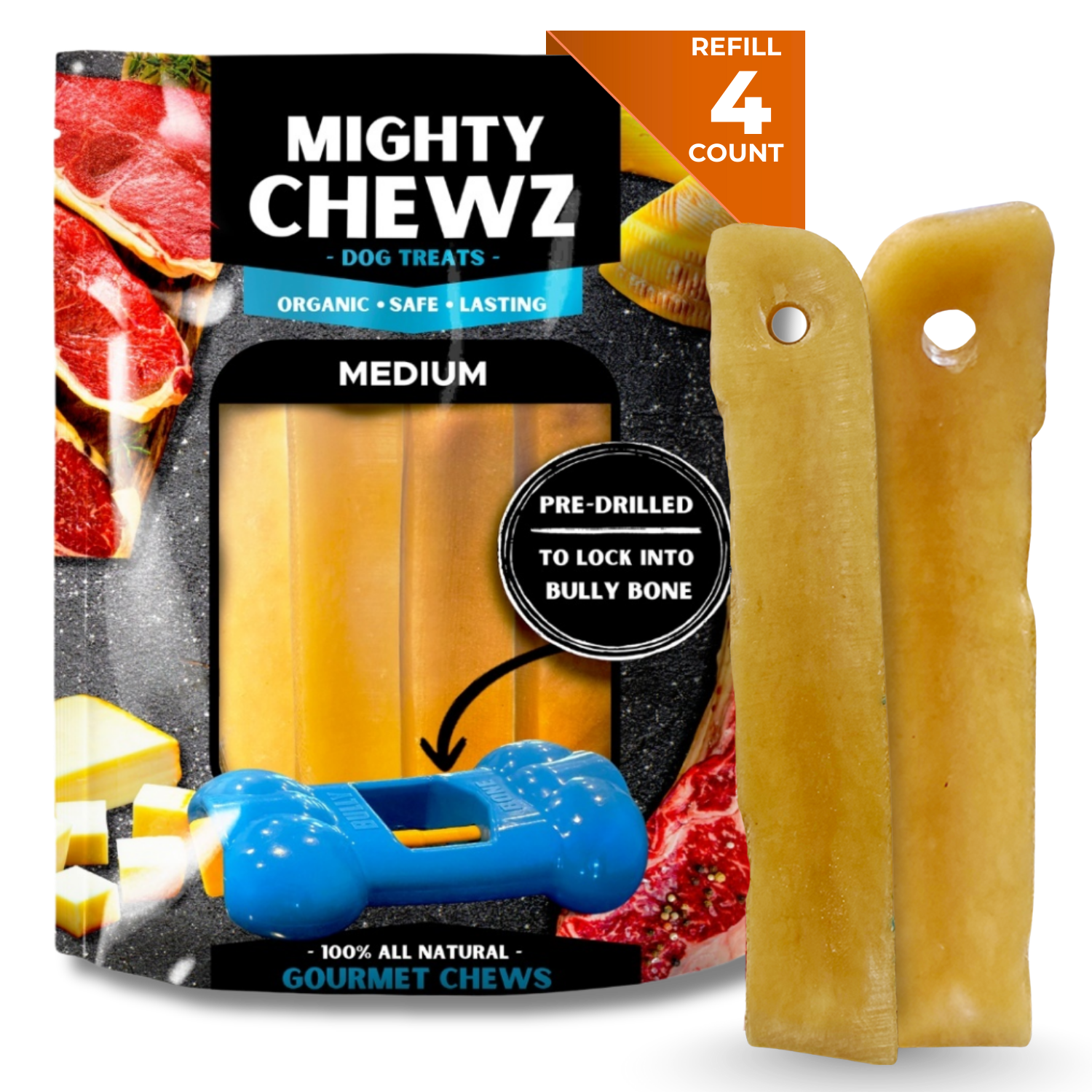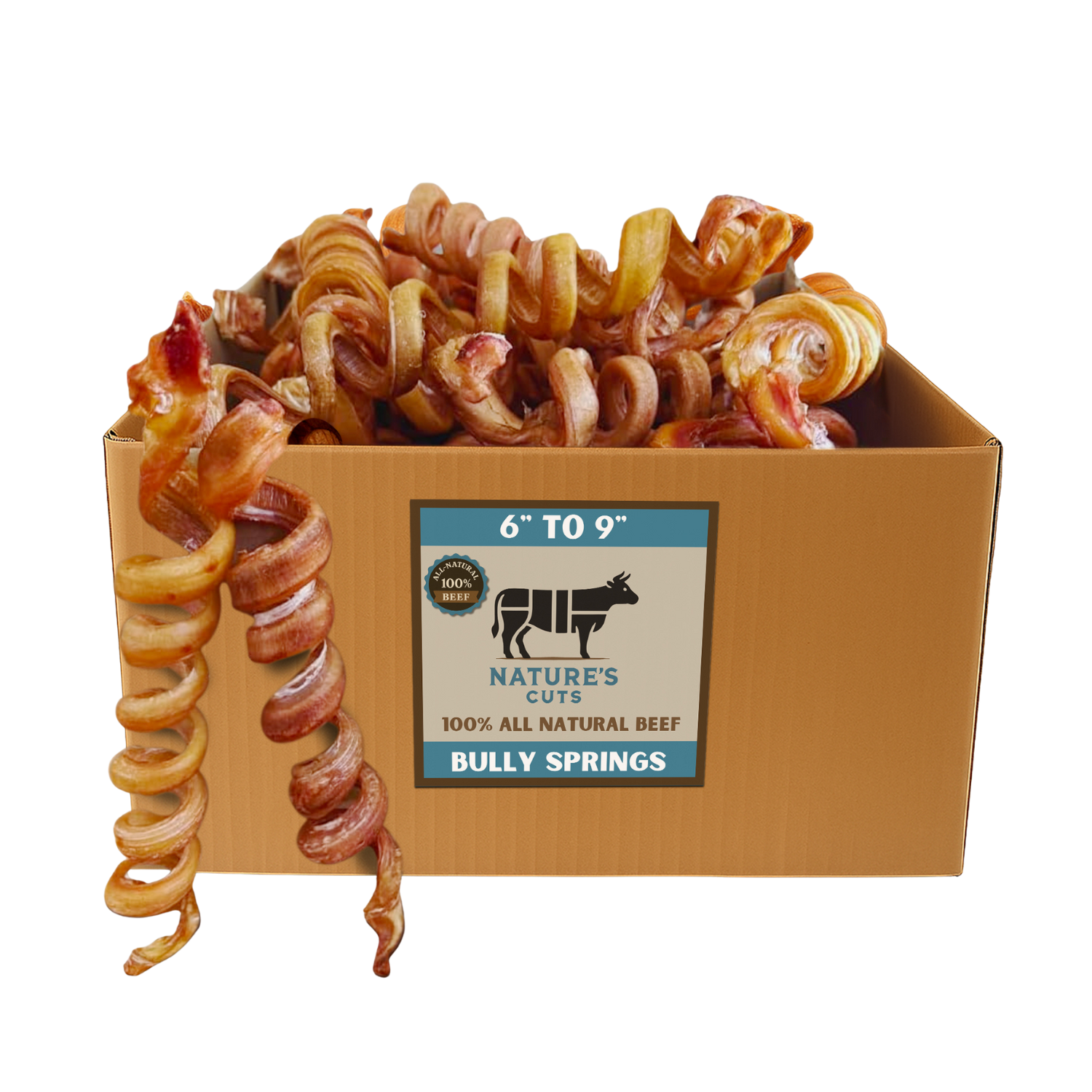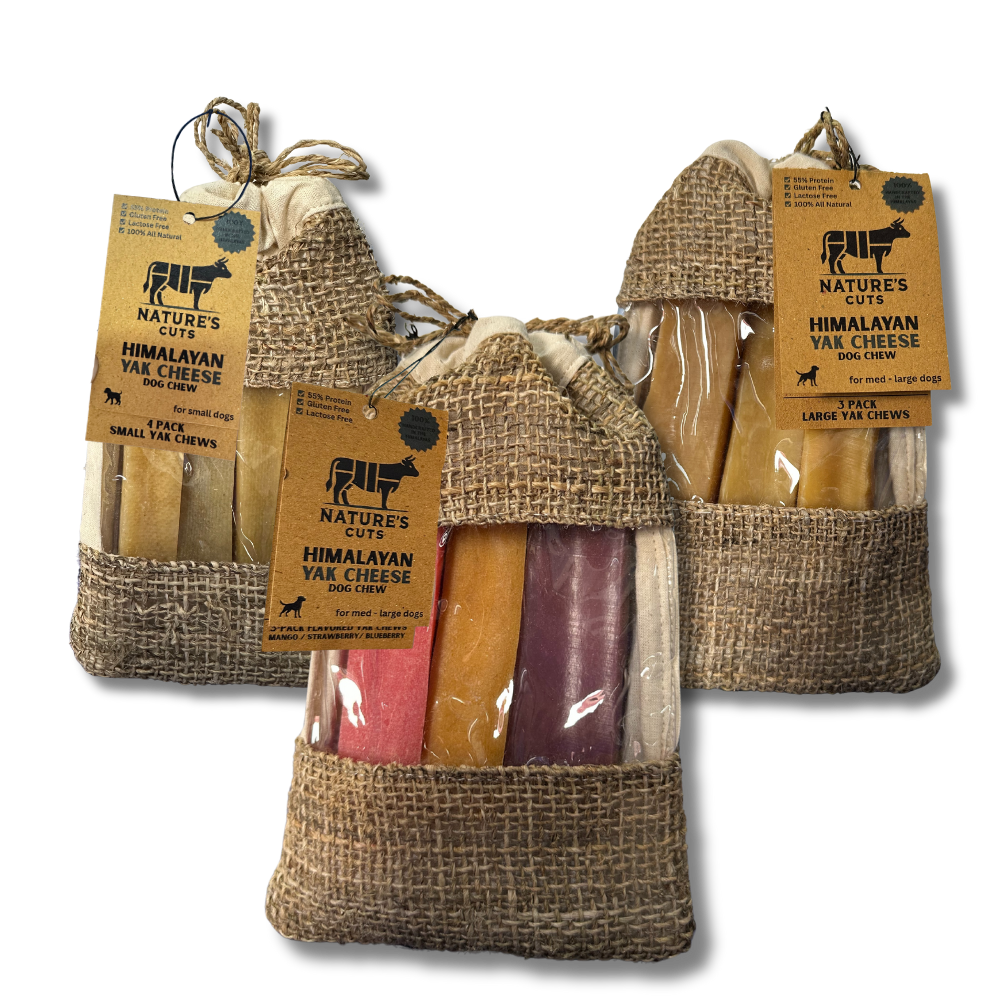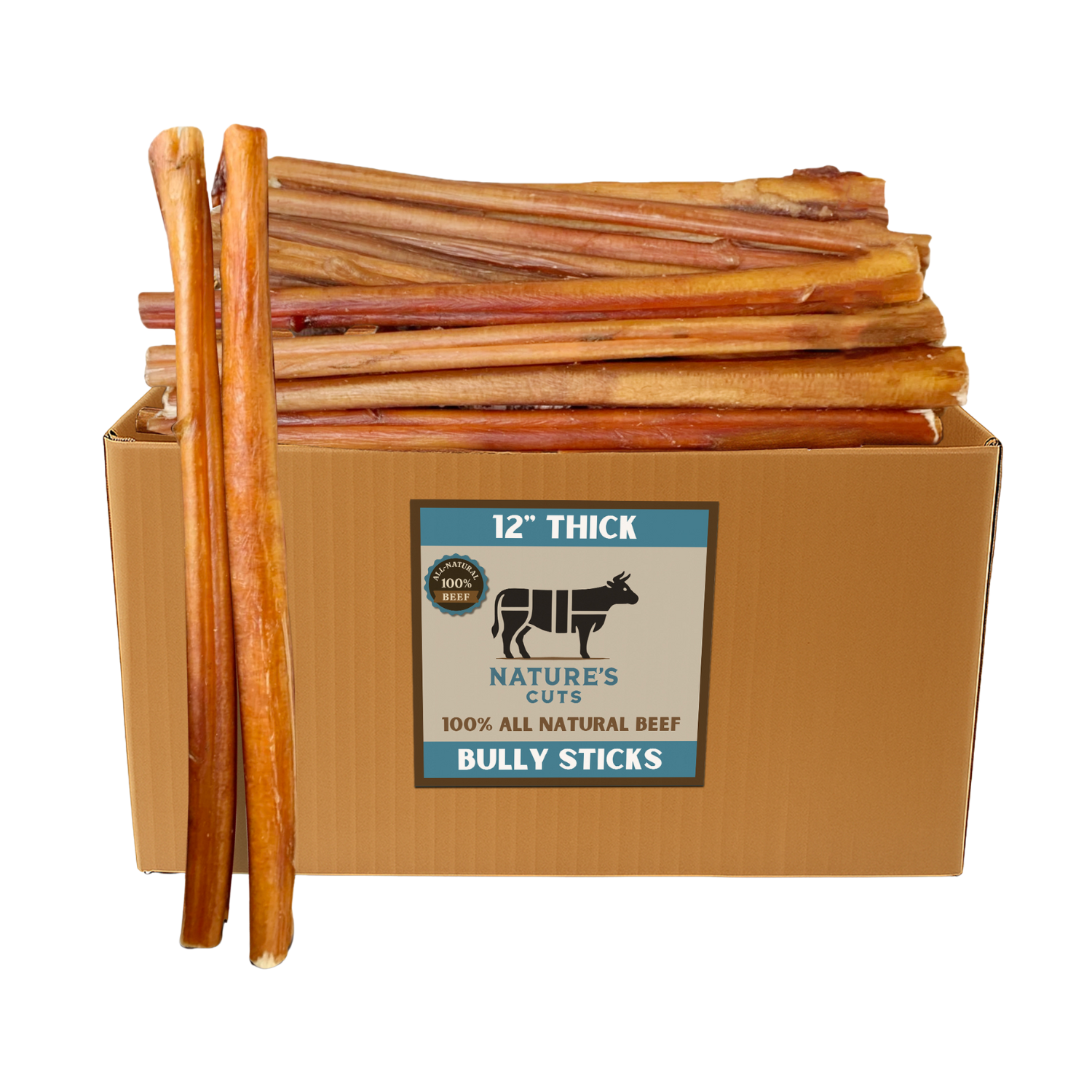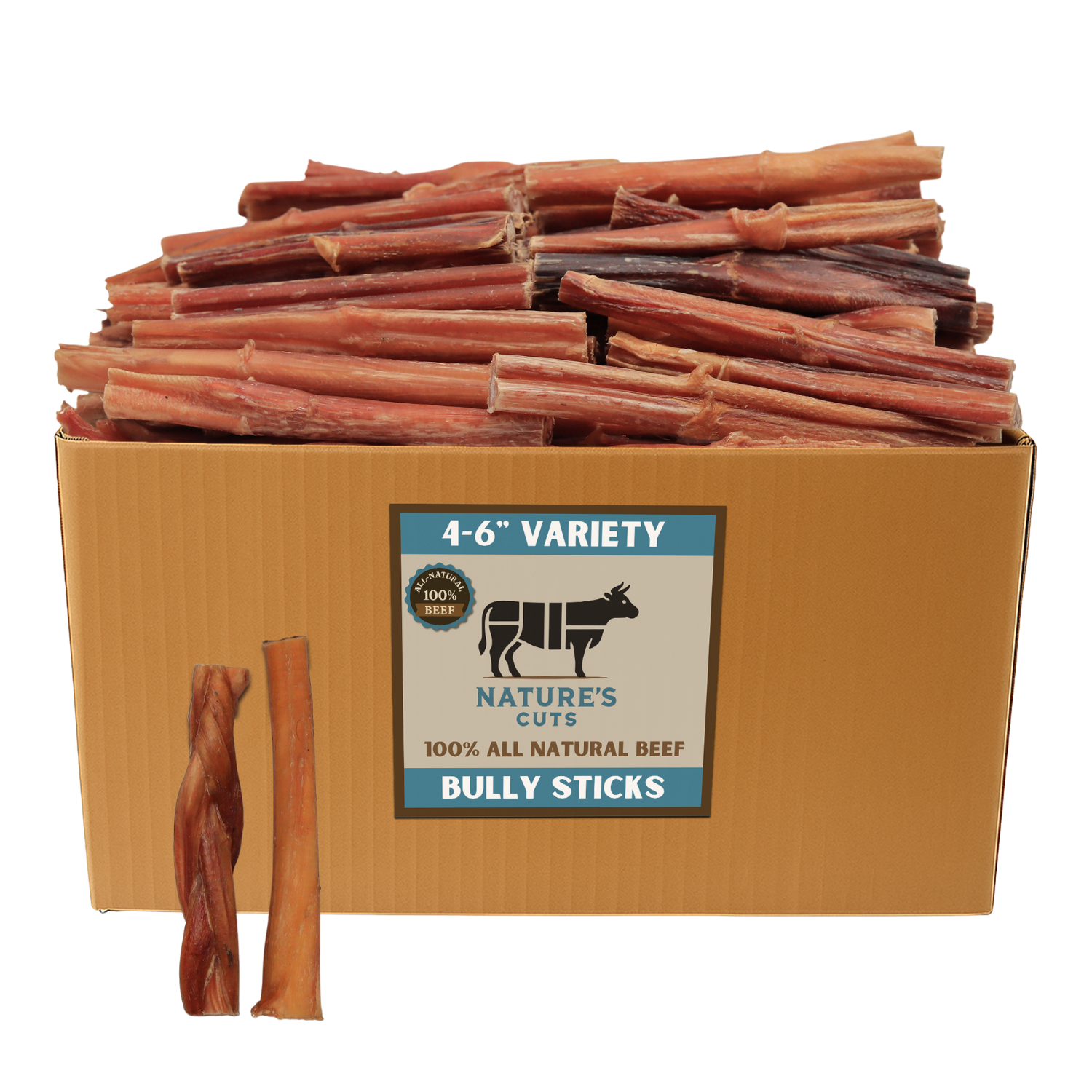Blogs

Blogs
Comparing Bully Sticks to Other Dog Chews: Making the Best Choice for Your Pooch
by Joshua Tipka on Feb 16 2024
As a responsible dog owner, you want the best for your four-legged friend, and that includes choosing the right dog chews. With so many options available, it can be challenging to decide which one is ideal for your furry companion. In this blog post, we'll take a closer look at the most popular dog chews on the market and compare them to one of the favorites: bully sticks. By the end of this article, you'll be equipped with the knowledge to make the best choice for your beloved pet.
1. Bully Sticks: A Natural Favorite
Bully sticks, also known as pizzle sticks, are derived from beef muscle, making them a natural and nutritious choice. They're free from artificial additives, preservatives, and unnecessary fillers, making them a safe option for dogs with food sensitivities. Unlike some chews that can pose choking hazards or digestive issues, bully sticks are easily digestible and unlikely to splinter, enhancing their safety.
2. Rawhide: The Controversial Choice
Rawhide chews have long been a staple for dog owners. They're inexpensive and widely available, but there are potential downsides. Rawhide can pose choking risks, as well as concerns about potential contamination and the use of chemicals in processing. If you choose rawhide, always supervise your dog and select high-quality, American-made options.
3. Dental Chews: Focused on Oral Health
Dental chews are specifically designed to improve your dog's oral hygiene. They often come in various shapes and sizes, promoting chewing and scraping away plaque and tartar. While they can be beneficial for dental health, they may not provide the same satisfaction and mental stimulation that bully sticks do.
4. Bones: A Classic Chew
Bones are a timeless choice for dogs, but there are risks involved. Cooked bones, in particular, can splinter and cause harm to your dog's mouth or digestive tract. While some types of raw bones can be a safer option, they still require careful supervision.
5. Antlers: The Natural Chew
Antlers are a natural and long-lasting option that some dogs enjoy. They are typically low in fat and don't splinter like bones, making them safer. However, antlers are extremely hard and can lead to dental damage if your dog is an aggressive chewer.
6. Synthetic Chews: A Safer Alternative
Synthetic chews, like Nylabones and rubber toys, offer a safe and durable option. These chews are designed to withstand rigorous chewing and can be stuffed with treats for added entertainment. They don't pose the same digestive or choking risks as some natural chews.
Making the Right Choice
When comparing bully sticks to other dog chews, it's clear that bully sticks offer a balance of naturalness, safety, and satisfaction that many other options can't match. However, the right choice for your dog ultimately depends on their size, age, chewing habits, and dietary restrictions. Regardless of your choice, always prioritize your dog's safety, supervise their chewing sessions, and consult with your veterinarian if you have any concerns about which chew is best for your pet.
In the end, the most important thing is to provide your furry friend with a safe and enjoyable chewing experience. Whether you opt for bully sticks, rawhide, dental chews, bones, antlers, or synthetic options, a happy and content dog is the ultimate goal.

Blogs
Bully Sticks vs. Rawhide: Making the Right Choice for Your Dog
by Joshua Tipka on Feb 11 2024
As a responsible dog owner, you want the best for your furry friend, and that includes providing safe and enjoyable chews. Two popular options often come up in the discussion of dog chews: bully sticks and rawhide. In this blog post, we'll compare these two options to help you make an informed decision about what's best for your canine companion.
1. Composition:
Bully Sticks:
Bully sticks are made from 100% beef muscle, specifically the pizzle (penis) of a bull.
They are a single-ingredient treat, free from artificial additives, making them a natural and wholesome choice for dogs.
Rawhide:
Rawhide is typically made from the inner layer of cow or horse hides.
It often undergoes a chemical process to remove hair and fat, which can introduce potential concerns about chemical residues.
2. Safety:
Bully Sticks:
Bully sticks are less likely to splinter compared to rawhide, reducing the risk of choking or intestinal blockages.
They are generally considered a safer option for dogs, especially aggressive chewers.
Rawhide:
Rawhide chews can pose a choking hazard if they break into smaller, sharp pieces.
There have been concerns about the digestibility of rawhide, as undigested pieces may accumulate in the digestive tract and cause problems.
3. Digestibility:
Bully Sticks:
Bully sticks are more easily digestible for dogs due to their natural composition.
They are less likely to cause digestive issues, making them a safer choice for many dogs.
Rawhide:
Rawhide can be challenging for some dogs to digest, which can lead to upset stomach or intestinal blockages.
4. Dental Benefits:
Bully Sticks:
Bully sticks offer dental benefits by helping to remove plaque and tartar as dogs chew, promoting better oral hygiene.
Rawhide:
While rawhide chews can also provide some dental benefits, they may be less effective than bully sticks in this regard.
5. Nutritional Value:
Bully Sticks:
Bully sticks are a good source of protein, and they can be a valuable supplement to your dog's diet.
Rawhide:
Rawhide has limited nutritional value and is primarily used as a chew rather than a dietary supplement.
6. Odor and Taste:
Bully Sticks:
Bully sticks have a natural odor that many dogs find appealing. They come in both traditional and odor-free varieties.
Rawhide:
Rawhide chews may have a milder odor, but they don't offer the same flavorful experience as bully sticks.
Conclusion:
When choosing between bully sticks and rawhide chews for your dog, it's essential to consider factors such as safety, digestibility, dental benefits, and nutritional value. Bully sticks, with their natural composition and multiple advantages, are often the preferred choice among dog owners. However, it's important to select the right size and supervise your dog during chewing sessions, regardless of the chew you choose. Remember that every dog is unique, so consult with your veterinarian if you have concerns about which chew is best for your pet. Ultimately, the goal is to provide a safe and enjoyable chewing experience that promotes your dog's well-being and happiness.

Blogs
The Benefits of Bully Sticks for Dogs:
by Joshua Tipka on Feb 06 2024
Are you searching for a natural and nutritious treat for your furry friend? Look no further than bully sticks! These delectable chews not only keep your dog happily occupied but also offer a myriad of health benefits. In this blog post, we'll explore why bully sticks are a top choice for dog owners seeking a satisfying and wholesome treat for their canine companions.
1. Excellent Dental Health:
One of the standout advantages of bully sticks is their positive impact on your dog's dental health. Chewing on these sticks helps remove plaque and tartar from your dog's teeth, promoting cleaner, healthier gums and preventing dental issues. Regular chewing can reduce the risk of periodontal disease, which is a common problem in dogs.
2. All-Natural Goodness:
Bully sticks are made from 100% beef muscle, making them a natural and wholesome treat for your dog. They contain no artificial additives or preservatives, making them a safe choice for dogs with food sensitivities or allergies. It's a treat you can feel good about giving to your furry friend.
3. Rich in Protein:
Dogs are carnivores, and bully sticks are a fantastic source of protein. Protein is essential for muscle development, overall growth, and maintaining a healthy coat. By giving your dog a bully stick, you're providing them with a protein-rich snack that supports their well-being.
4. Mental Stimulation:
Bully sticks offer more than just physical benefits; they provide mental stimulation as well. Chewing on a bully stick keeps your dog engaged and focused, preventing boredom and potentially destructive behavior. It's an excellent way to keep their minds sharp.
5. Low in Fat:
Compared to some other dog treats, bully sticks are relatively low in fat. This makes them an excellent option for dogs that need to watch their weight or those with pancreatitis or other fat-related health issues. You can offer a satisfying treat without worrying about excessive calories.
6. Long-Lasting Enjoyment:
Dogs love to chew, and bully sticks provide a long-lasting chewing experience. Unlike some treats that disappear in seconds, a bully stick can keep your dog entertained for hours. It's a great way to give your dog something enjoyable to do, especially when you need some time to yourself.
Bully sticks are more than just a tasty treat for your dog. They offer a wide range of benefits, including dental health, a natural and nutritious composition, protein content, mental stimulation, low fat, and long-lasting enjoyment. With these advantages, bully sticks are a fantastic choice for dog owners who want to provide their pets with a healthy and satisfying chew. So, go ahead and treat your furry friend to the goodness of bully sticks today, and watch them enjoy all the benefits these delicious chews have to offer. Your dog will thank you with a wagging tail and a bright, healthy smile!

Blogs
Bully Sticks FAQs: All Your Questions Answered
by Joshua Tipka on Oct 22 2023
Bully sticks have become a popular treat for dogs, prized for their natural and nutritious qualities. But with popularity comes curiosity, and many dog owners have questions about these tasty chews. In this blog post, we'll address the most frequently asked questions (FAQs) about bully sticks to help you make informed decisions about these delectable treats for your canine companion.
1. What Are Bully Sticks?
Bully sticks, also known as pizzle sticks, are natural dog chews made from the pizzle (penis) of a bull. They are processed, dehydrated, and roasted to create a long-lasting, flavorful treat.
2. Are Bully Sticks Safe for Dogs?
Yes, bully sticks are generally considered safe for dogs. However, it's crucial to choose high-quality, natural options from reputable manufacturers. Always supervise your dog while they're enjoying a bully stick to ensure their safety.
3. What Are the Benefits of Bully Sticks for Dogs?
Bully sticks offer several benefits, including promoting dental health, providing mental stimulation, serving as a source of protein, and being a natural and nutritious treat.
4. Are Bully Sticks Suitable for Puppies?
Bully sticks can be suitable for puppies, but it's important to choose the right size and supervise your puppy while they're chewing. Introduce them at an appropriate age, typically when your puppy begins teething.
5. Are Bully Sticks Suitable for All Dog Breeds?
Bully sticks are suitable for most dog breeds, but choose the size that matches your dog's chewing habits and monitor their behavior. Some large breeds may require thicker or longer bully sticks.
6. Are There Odor-Free Bully Sticks?
Yes, you can find odor-free bully sticks. These sticks are processed to reduce or eliminate the natural odor associated with them. They offer a more pleasant chewing experience for both you and your dog.
7. Can Dogs Swallow or Choke on Bully Sticks?
While bully sticks are generally safe, dogs can potentially swallow or choke on small pieces. Always supervise your dog while they're chewing, and select the right size for their safety.
8. How Should I Store Bully Sticks?
Store bully sticks in a cool, dry place to maintain their freshness. Sealing them in an airtight container can help prevent them from drying out.
9. Are Bully Sticks a Good Option for Dogs with Allergies?
Bully sticks are a single-ingredient treat made from beef, which can be suitable for dogs with food allergies or sensitivities. However, monitor your dog for any adverse reactions.
10. How Often Can I Give My Dog Bully Sticks?
The frequency of giving your dog bully sticks depends on their size, age, and dietary needs. As a general guideline, you can offer them as an occasional treat or as part of your dog's regular chewing routine.
Conclusion:
Bully sticks are a delicious and natural choice for dog owners looking to provide their pets with a safe and enjoyable chew. By addressing these frequently asked questions, we hope to assist you in making informed decisions about incorporating bully sticks into your dog's diet and playtime. Remember that each dog is unique, so it's essential to adapt to their specific needs and preferences to ensure their happiness and well-being.

Blogs
How Long Puppies Teethe: A Guide to Your Puppy's Dental Development
by Joshua Tipka on Oct 22 2023
Welcoming a new puppy into your home is an exciting adventure, but it also comes with many questions, especially regarding your puppy's growth and development. One crucial aspect of a puppy's early life is teething, which can influence their behavior, health, and the condition of your belongings. In this blog post, we will explore the fascinating process of how long puppies teethe and what you can do to support them during this period.
1. When Does Teething Begin?
Puppies start teething at a remarkably young age, typically around 3 to 6 weeks old. During this phase, puppies are still with their mother and littermates, learning essential social skills and beginning their journey into the world of solid food.
2. The Teething Timeline:
Teething is a gradual process that can be broken down into several stages:
Deciduous Teeth: Puppies are born without teeth, but within a few weeks, deciduous (baby) teeth begin to emerge.
6-8 Weeks: By this stage, puppies usually have a full set of baby teeth. They will have 28 baby teeth, including incisors, canines, and premolars.
3-4 Months: The teething process intensifies as the baby teeth start to loosen and fall out. This makes way for the permanent teeth to grow in their place. This phase can be quite uncomfortable for your puppy, leading to increased chewing behavior and discomfort.
6 Months: At around 6 months of age, most puppies have their full set of 42 permanent teeth. The transition from baby teeth to adult teeth is usually complete by this point.
3. Signs of Teething:
Puppies may exhibit various signs of teething, including:
Chewing: An instinctual response to alleviate discomfort. Providing appropriate chew toys can help redirect their chewing behavior.
Irritability: Teething can be uncomfortable, leading to mood changes or increased sensitivity.
Excessive Drooling: As new teeth erupt, your puppy may produce more saliva.
Loss of Baby Teeth: You may notice small teeth on the floor or in your puppy's food.
4. How to Support Your Teething Puppy:
Chew Toys: Offer a variety of puppy-safe chew toys to help alleviate the discomfort and redirect their chewing habits from your furniture.
Frozen Treats: Provide frozen treats or ice cubes to help numb sore gums.
Gentle Play: Avoid tug-of-war or games that may stress your puppy's mouth while they are teething.
Regular Dental Care: Start gentle dental care practices early to establish a lifelong dental hygiene routine.
Veterinary Checkup: Ensure your puppy's teeth are developing correctly and address any concerns with your veterinarian.
5. When to Seek Veterinary Advice:
If your puppy's teething process seems overly painful or prolonged, or if they experience excessive bleeding or swelling, consult your veterinarian for guidance.
Conclusion:
Teething is a natural and important part of your puppy's development. Understanding the timeline and supporting your puppy through this phase with appropriate chew toys and care will help ensure a healthy transition from baby teeth to permanent teeth. By being patient, attentive, and proactive, you can make the teething process as comfortable as possible for your new furry family member.
